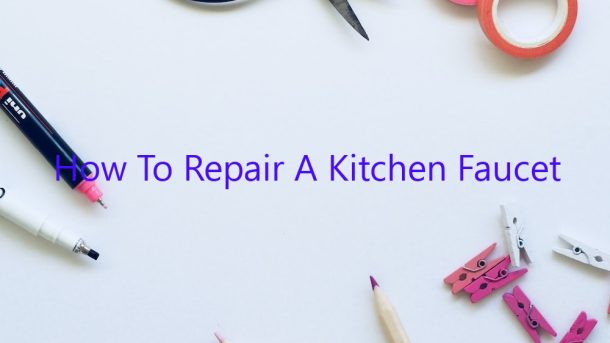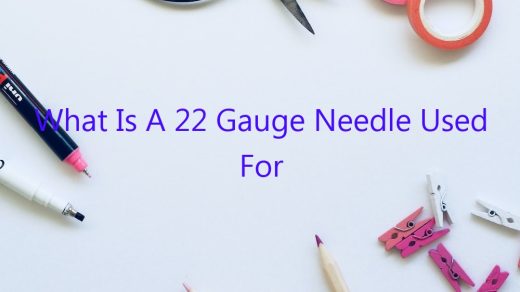If you’re like most homeowners, your kitchen faucet sees a lot of action. From filling pots and pans to washing dishes and vegetables, your kitchen faucet is a vital part of your daily routine. So when it starts to leak or doesn’t seem to be working quite right, it can be a major annoyance. But before you run out and buy a new faucet, try repairing it yourself.
Repairing a kitchen faucet is a relatively easy task, and with the right tools and instructions, you can have it fixed in no time. Here’s a look at how to repair a kitchen faucet:
1. Shut off the water supply to the faucet.
2. Disconnect the faucet from the sink.
3. Remove the faucet handle.
4. Remove the faucet aerator.
5. Clean the aerator.
6. Inspect the valve seats.
7. Repair the valve seats, if necessary.
8. Reassemble the faucet.
9. Reconnect the faucet to the sink.
10. Turn on the water supply and check for leaks.
Shutting off the water supply to the faucet is the first step in repairing it. Next, you’ll need to disconnect the faucet from the sink. This can be done by unscrewing the connectors at the base of the faucet. Once the connectors are free, you can lift the faucet off the sink.
Now that the faucet is free, you can start to remove the parts. The first piece you’ll want to remove is the handle. This is usually held in place by a screw or a clip, so just use a screwdriver or a pair of pliers to remove it.
Next, you’ll want to remove the aerator. This is the small screen on the end of the faucet that helps to aerate the water. To remove it, just unscrew it and pull it off.
Once the aerator is off, you can clean it. Use a toothbrush or a pipe cleaner to clean the inside of the aerator. Be sure to remove any debris or mineral build-up.
Now it’s time to inspect the valve seats. The valve seats are the part of the faucet that the water flows over. If they’re damaged or corroded, the faucet will leak. To inspect them, use a magnifying glass and a flashlight. If they’re damaged, you’ll need to repair them.
If the valve seats need to be repaired, you’ll need to remove the faucet head. This is the part of the faucet that sits on the sink. To remove it, you’ll need to loosen the screws that hold it in place. Once the screws are free, you can pull the faucet head off.
Once the head is off, you can access the valve seats. Use a wrench to remove the seats and then replace them with new ones. Be sure to use the same size and type of seat as the original.
Once the seats are replaced, you can reassemble the faucet. Start by putting the faucet head back in place and then tighten the screws. Next, reattach the aerator and then put the handle back on. Finally, reconnect the faucet to the sink and turn on the water supply.
Check for leaks and then you’re done. Repairing a kitchen faucet is a relatively easy task
Contents [hide]
How do I fix a single handle kitchen faucet?
A single handle kitchen faucet is a common type of faucet found in kitchens. It is operated by a single handle that moves up and down to control the flow of water. If your single handle kitchen faucet is not working properly, there are a few things you can do to fix it.
The first thing you should do is check the water supply. Make sure the water is turned on and that there is enough pressure coming from the faucet. If the water is turned off or there is not enough pressure, the faucet will not work properly.
If the water is turned on and there is enough pressure, the next thing you should do is check the faucet head. The head is the part of the faucet that the water comes out of. If the head is clogged, the faucet will not work properly. You can clean the head by using a toothpick or a needle to clear any clogs.
If the water is turned on and there is enough pressure and the head is not clogged, the next thing you should do is check the faucet handle. The handle is the part of the faucet that you use to control the flow of water. If the handle is not working properly, it may need to be replaced.
If the water is turned on and there is enough pressure, the head is not clogged, and the handle is not working properly, the last thing you can do is call a plumber. A plumber can help you fix the faucet if it is not working properly.
Can a kitchen faucet be repaired?
Can a kitchen faucet be repaired?
In many cases, the answer to this question is yes. Kitchen faucets are relatively easy to repair, and most common problems can be fixed with a few simple tools. However, there are a few things to keep in mind before attempting to repair a kitchen faucet yourself.
One of the most common problems with kitchen faucets is a leaky faucet. If your faucet is leaking, the first thing you should do is determine the source of the leak. There are several possible causes of a leaky kitchen faucet, and each one requires a different repair. Once you have determined the source of the leak, you can begin to repair it.
If your kitchen faucet is not leaking, but it is not working properly, the first thing you should do is determine the type of faucet you have. There are two types of kitchen faucets: cartridge and ball. Each type has its own repair instructions.
If you are not sure how to determine the type of faucet you have, or if you are experiencing a problem that is not listed here, you can consult a professional plumber for assistance.
How do you disassemble a kitchen faucet?
A kitchen faucet is a common household fixture that is used to dispense water. It is typically mounted on the wall above the sink. Over time, the faucet may become clogged or leak, which may necessitate its disassembly for repair or replacement.
Most kitchen faucets consist of four main parts: the faucet body, the handle, the cartridge, and the spout. The faucet body is the largest and most visible part of the faucet. It is typically made of brass or plastic and contains the water inlets and outlets. The handle is attached to the faucet body and is used to control the flow of water. The cartridge is a cylindrical component that is responsible for regulating the water flow. The spout is the outlet for the water and is attached to the cartridge.
Before disassembling a kitchen faucet, be sure to turn off the water supply to the faucet. Then, loosen the faucet handle to allow any water in the lines to drain out. Next, remove the decorative cap that covers the faucet handle screw. Finally, remove the handle screw and remove the handle.
Now, you can begin disassembling the faucet. First, remove the nut that connects the faucet body to the cartridge. Then, remove the cartridge from the faucet body. Next, remove the O-ring from the cartridge. Finally, remove the spout from the cartridge.
To reassemble the faucet, follow these same steps in reverse. Be sure to replace the O-ring on the cartridge and the nut that connects the cartridge to the faucet body. Also, be sure to tighten the handle screw securely.
How can I repair a kitchen faucet that’s leaking?
If your kitchen faucet is leaking, you have a few different repair options to choose from. The most common option is to replace the washer inside the faucet. This is a fairly easy fix and can be done in just a few minutes.
Another option is to replace the entire faucet. This can be a more difficult task, but it may be necessary if the faucet is old or damaged.
If you’re not sure how to fix your kitchen faucet, you can always call a plumber for help.
How do I know if my faucet cartridge is bad?
A faucet cartridge is a device that helps control the flow of water through a faucet. It is a plastic or metal cylinder that is inserted into the faucet body. The cartridge has a number of small holes in it that allow water to pass through.
If your faucet is not working properly, it may be due to a bad cartridge. A bad cartridge can cause the faucet to leak, dribble, or not turn on at all.
If you think your cartridge may be bad, there are a few things you can do to test it.
One way to test a cartridge is to block the holes with your fingers and turn on the faucet. If the faucet doesn’t turn on, the cartridge is likely bad.
You can also try removing the cartridge and shaking it. If you hear water sloshing around inside, the cartridge is likely bad.
If you are unsure whether or not your cartridge is bad, you can take it to a hardware store or plumbing supply store to have it tested.
How do you take apart a single handle faucet?
A single handle faucet is a type of faucet that has a single handle that controls both the temperature and the flow of water. These faucets are common in kitchens and bathrooms. If you need to take apart a single handle faucet, there are a few things you will need to do.
The first thing you will need to do is to find the screw that holds the handle in place. This screw is usually located at the base of the handle. Once you have found the screw, use a screwdriver to remove it.
Once the screw is removed, you can pull the handle off of the faucet. Be careful not to damage the handle or the faucet.
Once the handle is off, you can access the valve. The valve is the part of the faucet that controls the water flow. To remove the valve, you will need to remove the screws that hold it in place.
Once the screws are removed, you can pull the valve out of the faucet. Be careful not to damage the valve.
If you need to replace the valve, you can purchase a replacement valve at most hardware stores.
Once the valve is replaced, you can put the faucet back together by reversing the steps you took to take it apart.
How do you replace an O ring in a kitchen faucet?
Replacing an O ring in a kitchen faucet is a relatively simple process that can be completed in a few minutes. The most important thing to remember is to use the correct size O ring, as a poorly fitted O ring can cause leaks.
To replace an O ring in a kitchen faucet, start by draining the faucet. Next, remove the handle by unscrewing it from the faucet. Remove the screws that hold the faucet in place and lift it out. The O ring is located at the base of the faucet, where it meets the water supply line. Remove the old O ring and replace it with a new one. Make sure the new O ring is properly fitted and reattach the faucet. Reattach the handle and test the faucet for leaks.




